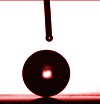 Scientists sure know how to have fun, Iain “Beaker” Larmour and Lauren “Comical Flasks” Rutherford of QUB, in Norther Ireland, square up for the match of the century playing micro mechanical hockey on a super water repellent, a superhydrophobic, material, that makes a duck’s back look positively damp.
Scientists sure know how to have fun, Iain “Beaker” Larmour and Lauren “Comical Flasks” Rutherford of QUB, in Norther Ireland, square up for the match of the century playing micro mechanical hockey on a super water repellent, a superhydrophobic, material, that makes a duck’s back look positively damp.
There is a serious objective to this work. Superhydrophobic materials have been sought for many years. “Much of the recent research on hydrophobic materials has been inspired by the water-repellent nature of lotus leaves,” says team leader Steven Bell, “they show a double roughness on their surfaces (nanohairs on microbumps) along with a waxy coating. Very few materials have come anywhere near being this hydrophobic, or water hating though. Bell and his colleagues, Graham Saunders and Iain Larmour have now developed a remarkably straightforward method for treating metals which mimics the microstructure of lotus leaves. “The process simply involves dipping the object to be coated in a solution of silver or gold ions, this coats them with a double-roughness metal layer thinner than a human hair. Secondly the object is dipped in a solution which creates single layer of water-repelling fluorinated molecules similar to Teflon.” The resulting surfaces are so water repellent that they can be immersed in water for several days, but are completely dry when removed. Similarly, drops of water deposited on the surface form almost perfect spheres that roll off unless the surface is kept completely flat. “The surface tension in these water ‘balls’ is strong enough to hold them together during the hockey game in the video,” Bell told Sciencebase.
Sharp-eyed readers will probably be wondering about how they players scored. “The goal areas in the hockey field were treated to make them hydrophillic (water loving) so that drops that roll over them get temporarily trapped,” Bell told me.
The research is published in Angew Chem